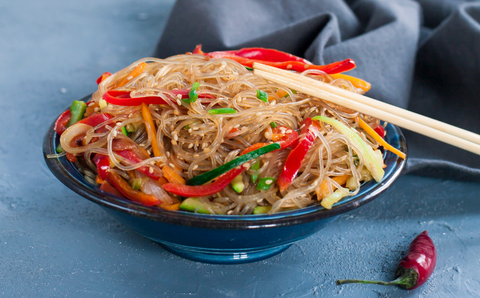
29 Mar Japchae and Exploring Korean Cuisine
I’ve been obsessed with kai much of my life. My mum can attest to the fact that my favourite programme growing up was the food channel. Her and my whānau have had to be at the receiving end of much of my kai experimentation. I’m assuming that their ongoing support has meant I’ve succeeded more than I’ve failed. But early this year I’ve been getting quite bored with cooking and it’s because I’m bored of the largely European influenced flavours that I grew up learning about. I needed something new!
Luckily, my latest obsession (lol) has been Korean food. This originated after watching the three part series, ‘A nation of Broth’, which explored the intergenerational place of broth in Korean cuisine and culture. It was such a beautiful watch, and reminded me a lot of the nostalgia I still feel at getting to eat my dads boil up. This may be a controversial take, but in case you didn’t know Koreans actually make the best Pork bones. It often appears on Korean menus as potato soup.
In any case, this recent obsession has reignited my love of cooking. I’ve tried a few Korean dishes from Budae Jigae (an army stew), Gimbap (Korean sushi) and Japchae pictured below. Japchae is a beautiful, easy and accessible dish that is made from sweet potato noodles which can now be found at many New Worlds, and of course at asian supermarkets. The noodles make this dish gluten free which I know is a bonus for many of our whānau with gluten allergies. Heoi anō it’s a sweet potato noodle dish with lots of vegetables – carrots, onions, spinach, mushrooms and protein – eggs, and whatever meats or tofu you like.
The recipe written below is an adaptation of a recipe from this webpage https://kimchimari.com/japchae/. The adaptation takes into account that I want to make this dish quickly, creating as few dishes as possible and also don’t have all of the ingredients including the meat. However if you have the time and are keen to make the real deal, head to the link above. Hope you enjoy!
Japchae (Vegetarian)
Feeds 5-6 people as a stand alone dish
Takes 30 minutes with two sets of hands.
Ingredients
2 Tbsp canola oil or vegetable oil
1 medium carrot , julienned
1 medium onion , sliced thin
1 bunch spinach
6 white button mushrooms
2 Eggs
230 grams Korean glass noodles or cellophane noodles (Dangmyeon)
2 Spring onions
Sauce
3.5 Tbsp soy sauce
1.5 Tbsp sugar
2 Tbsp sesame oil
1 Tbsp sesame seeds
Step 1: Make the sauce
Make the sauce by mixing together the soy, sugar and sesame oil
Step 2: Prepare the vegetables
Julienne the carrots and onions. Slice the mushrooms. Cut the spring onions long ways and then into 3 inch long match sticks. Blanch the spinach for 40 seconds and then shock with cold water to stop cooking. It’s tempting to miss this step, but cooking the spinach in the pan will release a lot of water into the mix, and everything will just boil. Ring the water out of the spinach and set aside.
Step 3: Cook the noodles
Cook the sweet potato starch/glass noodles according to the packet instructions, you could even undercook them by a minute. Once cooked, shock with cold water to stop cooking and drizzle with a little bit of sesame oil to prevent sticking. Use a pair of scissors to cut the noodles.
Step 4: Cook the egg
Beat the eggs into a scramble. Heat oil in a pan, and fry the egg omelette style. Once ready, take out of the pan, wait to cool and slice into strips.
Step 5: Cooking everything together
Set the pan to a medium heat. Add more oil to the pan, cook the onions and carrots for a couple of minutes, add the mushrooms for a couple of minutes. Add the spring onion and cook for thirty seconds. Once all of the vegetables are al dente, add the noodles, spinach, eggs and sauce into the pan and mix. Let cook for a few minutes. This dish can be served at room temperature, but I prefer it warm so I keep it on the heat until the noodles are warmed through.
Top with toasted sesame seeds and serve.

Haylee Koroi
Haylee (Te Rarawa, Ngāpuhi, Ngati Kahu) is Kaiārahi for Kai Māori Kai Ora at Toi Tangata.



